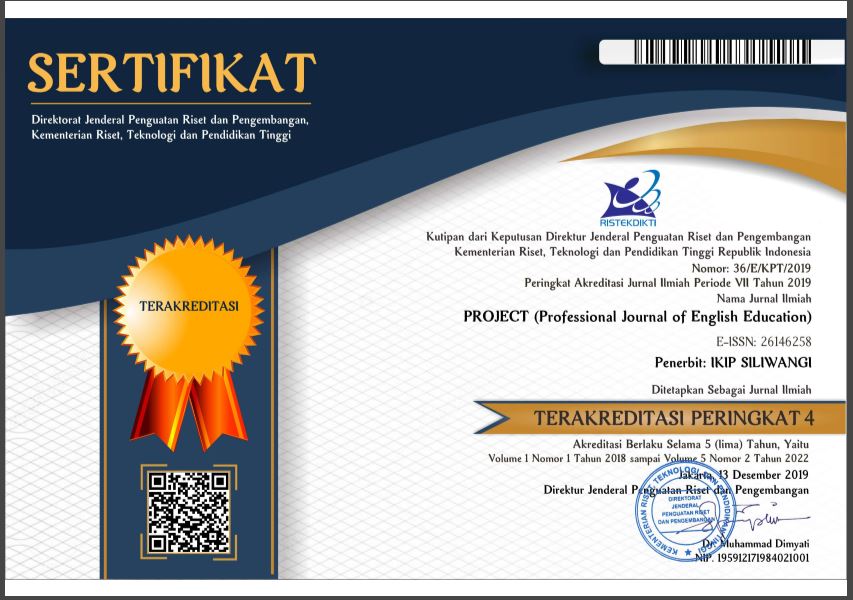INEQUALITY TOWARDS WOMEN IN BATTLE OF THE SEXES
DOI:
https://doi.org/10.22460/project.v6i4.p738-747Abstract
Gender inequality mostly contributes to women having less access than men. This study explores how women are represented unequally in the movie Battle of the Sexes. The data were taken from monologues and dialogues among the characters throughout the movie. Then, we analyzed the data by using Sara Mills' critical discourse analysis (1992). To support the findings, we also categorized forms of gender inequality according to Fakih's theory (2012). The results showed that even though they occasionally can voice their concern, they still struggle to achieve equality since men have more power than them. Additional findings also show that forms of inequality are found except double burden. This study concludes that patriarchal culture holds accountable for this issue. Therefore, if gender inequality still occurs in our society, women will likely have less access to everything and eventually be left behind.
Â
Keywords:Â Critical Discourse Analysis; Gender Inequality; Patriarchy; Sara Mills
References
Akhter, T. (2020). Gender Inequality and Literature: A Contemporary Issue. Proceedings of the 6th International Conference on Social and Political Sciences (ICOSAPS 2020). https://doi.org/10.2991/assehr.k.201219.090
Ali, M., & Decker, A. (2015). Effect of Gender Inequality on Economic Growth (Case of Pakistan). Journal of Economics and Sustainable Development, 6(9). https://www.iiste.org/Journals/index.php/JEDS/article/view/22620
Alkan, Ö., Serçemeli, C., & Özmen, K. (2022). Verbal and psychological violence against women in Turkey and its determinants. PLoS ONE, 17(10). https://doi.org/10.1371/journal.pone.0275950
Arceo-Gomez, E. O., & Campos-Vazquez, R. M. (2022). Gender Bias in Evaluation Processes. Economics of Education Review, 89. https://doi.org/10.1016/j.econedurev.2022.102272
Ayllón, S. (2022). Online teaching and gender bias. Economics of Education Review, 89, 102280. https://doi.org/10.13039/501100011033
Beaufoy, S. (2019). Battle of the Sexes (Audiovisual transcript). https://dg7kra6zb39sn.cloudfront.net/media/fyc/film-script/film_scripts-fcec2516-f3d6-4455-82b4-cd8c050edaa5.pdf.
Bilodeau, J., Marchand, A., & Demers, A. (2020). Psychological distress inequality between employed men and women: A gendered exposure model. SSM - Population Health, 11, 100626. https://doi.org/10.1016/j.ssmph.2020.100626
Blommaert, L., Meuleman, R., Leenheer, S., & ButkÄ“viÄa, A. (2020). The gender gap in job authority: Do social network resources matter? Acta Sociologica (United Kingdom), 63(4), 381–399. https://doi.org/10.1177/0001699319847504
Cuberes, D., & Teignier, M. (2014). Gender inequality and economic growth: A critical review. In Journal of International Development (Vol. 26, Issue 2, pp. 260–276). https://doi.org/10.1002/jid.2983
de Gioannis, E., Bianchi, F., & Squazzoni, F. (2022). Gender bias in the classroom: A network study on self and peer ability attribution. Social Networks, 72, 44–51. https://doi.org/10.1016/j.socnet.2022.09.001
Derdar, P. M. (2017). Gender and Verbal Violence: a Form of Psychological Abuse in Moroccan Popular Culture. Revue Sciences, Langage et Communication, 1(3). https://revues.imist.ma/index.php/SLC/article/view/10156
Elveren, A. Y. (2014). Women's labour force participation and pay inequality: Evidence from panel cointegration. Applied Economics Letters, 21(12), 862–865. https://doi.org/10.1080/13504851.2014.894622
England, P., Levine, A., & Mishel, E. (2020). Progress toward gender equality in the United States has slowed or stalled. Proceedings of the National Academy of Sciences. https://doi.org/10.1073/pnas.1918891117/-/DCSupplemental
Fakih, M. (2012). Analisis Gender dan Transformasi Sosial. Yogyakarta: Pustaka Pelajar.
Fitri, M., & Padmi, M. (2018). Female Masculinity and Power Relation in Patriarchic System: Case Study Tomboyism of Bacha Posh in Afghanistan. Nation State: Journal of International Studies, 1(1). https://doi.org/https://doi.org/10.24076/NSJIS.2018v1i1.89
GarcÃa-González, J., Forcén, P., & Jimenez-Sanchez, M. (2019). Men and women differ in their perception of gender bias in research institutions. PLOS ONE, 14(12), e0225763. https://doi.org/10.1371/journal.pone.0225763
Gauci, P., Elmir, R., O'Reilly, K., & Peters, K. (2022). Women's experiences of workplace gender discrimination in nursing: An integrative review. In Collegian (Vol. 29, Issue 2, pp. 188–200). Elsevier B.V. https://doi.org/10.1016/j.colegn.2021.08.003
Gupta, A. K., Kanu, P. K., & Lamsal, B. P. (2021). Gender Discrimination in Nepal: Does It Vary Across Socio-Demographics? Journal of Contemporary Sociological Issues, 1(2), 145. https://doi.org/10.19184/csi.v1i2.25592
Heilman, M. E. (2012). Gender stereotypes and workplace bias. In Research in Organizational Behavior (Vol. 32, pp. 113–135). JAWePress. https://doi.org/10.1016/j.riob.2012.11.003
Hiller, V. (2014). Gender Inequality, Endogenous Cultural Norms, and Economic Development. Source: The Scandinavian Journal of Economics, 116(2), 455–481. https://doi.org/10.1111/sjoe.12056
Kinias, Z., & Kim, H. S. (2012). Culture and gender inequality: Psychological consequences of perceiving gender inequality. Group Processes and Intergroup Relations, 15(1), 89–103. https://doi.org/10.1177/1368430211408940
Kubrak, T. (2020). Impact of films: Changes in young People's attitudes after watching a movie. Behavioral Sciences, 10(5). https://doi.org/10.3390/bs10050086
Langdon, D. L., & Klomegah, R. (2013). Gender Wage Gap and Its Associated Factors: An Examination of Traditional Gender Ideology, Education, and Occupation. Source: International Review of Modern Sociology, 39(2), 173–203. https://www.jstor.org/stable/43496468
Larasati, A. M., & Ayu, N. P. (2020). The Education for Gender Equality and Human Rights in Indonesia: Contemporary Issues and Controversial Problems. The Indonesian Journal of International Clinical Legal Education, 2(1), 73–84. https://doi.org/10.15294/ijicle.v2i1.37321
Mills, S. (1992). Knowing your place: A Marxist feminist stylistic analysis. In M. Toolan (Ed.), Language, text, and context: Essays in stylistics . London and New York: Routledge.
Nash, C. J. (2020). Patriarchy. In International Encyclopedia of Human Geography (pp. 43–47). Elsevier. https://doi.org/10.1016/B978-0-08-102295-5.10206-9
Nguyen, C. P. (2021). Gender equality and economic complexity. Economic Systems, 45(4), 100921. https://doi.org/10.1016/j.ecosys.2021.100921
Nguyen, C. P. (2022). Uncertainty and gender inequality: A global investigation. Quarterly Review of Economics and Finance, 86, 31–47. https://doi.org/10.1016/j.qref.2022.06.003
Njoki, W. (2021). Gender Discriminations in The Workplace: A Critical Literature Review. Journal of Gender Related Studies, 2(2), 9–17. https://www.carijournals.org/journals/index.php/JGRS/article/download/744/961
Page, S. J., & Yip, A. K. T. (2017). Gender equality and religion: A multi-faith exploration of young adults' narratives. European Journal of Women's Studies, 24(3), 249–265. https://doi.org/10.1177/1350506815625906
Rawat, P. S. (2014). Patriarchal Beliefs, Women's Empowerment, and General Well-being. Vikalpa: The Journal for Decision Makers, 39(2), 43–56. https://doi.org/10.1177/0256090920140206
Scarborough, W. J., Lambouths, D. L., & Holbrook, A. L. (2019). Support of workplace diversity policies: The role of race, gender, and beliefs about inequality. Social Science Research, 79, 194–210. https://doi.org/https://doi.org/10.1016/j.ssresearch.2019.01.002
Siddiqi, N. (2021). Gender inequality as a social construction in India: A phenomenological enquiry. Women's Studies International Forum, 86. https://doi.org/10.1016/j.wsif.2021.102472
Stamarski, C. S., & Son Hing, L. S. (2015). Gender inequalities in the workplace: the effects of organizational structures, processes, practices, and decision makers' sexism. In Frontiers in Psychology (Vol. 6). Frontiers Media S.A. https://doi.org/10.3389/fpsyg.2015.01400
Sterling, A. D., Thompson, M. E., Wang, S., Kusimo, A., Gilmartin, S., & Sheppard, S. (2020). The confidence gap predicts the gender pay gap among STEM graduates. Proceedings of the National Academy of Sciences, 117(48), 30303–30308. https://doi.org/10.1073/pnas.2010269117
Sultana, A. (2012). Patriarchy and Women's Subordination: A Theoretical Analysis. Arts Faculty Journal, 1–18. https://doi.org/10.3329/afj.v4i0.12929
Tabassum, N., & Nayak, B. S. (2021). Gender Stereotypes and Their Impact on Women's Career Progressions from a Managerial Perspective. IIM Kozhikode Society & Management Review, 10(2), 192–208. https://doi.org/10.1177/2277975220975513
Walby, S. (1990). Theorizing patriarchy. Basil Blackwell.
Wickman, K., Lofgren, K., Eliasson, I., & Nordlund, M. (2015). Gender equality and Sport. An equation difficult to solve. Swedish Journal of Sport Research., 110–137. https://www.researchgate.net/publication/278606633_Gender_equality_and_Sport_An_equation_difficult_to_solve
Xu, H., Zhang, Z., Wu, L., & Wang, C. J. (2019). The Cinderella complex: Word embeddings reveal gender stereotypes in movies and books. PLoS ONE, 14(11). https://doi.org/10.1371/journal.pone.0225385
Young, G., Fort, L., & Danner, M. (1994). Moving from `The Status Of Women' to `Gender Inequality': Conceptualisation, Social Indicators and an Empirical Application. International Sociology, 9(1), 55–85. https://doi.org/https://doi.org/10.1177/02685809400900100
Zahrai, L. (2014). An Individual's Gender Experience: Socio-Cultural Context. Journal of Vasyl Stefanyk Precarpathian National University, 1(4), 115–122. https://doi.org/10.15330/jpnu.1.4.115-122
Zhu, Z. (2021). The Causes and Solutions of Gender Inequality in the Workplace. 2021 4th International Conference on Humanities Education and Social Sciences (ICHESS 2021). https://www.atlantis-press.com/proceedings/ichess-21/125967127




